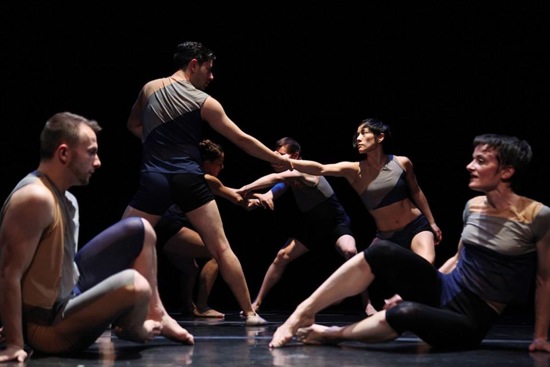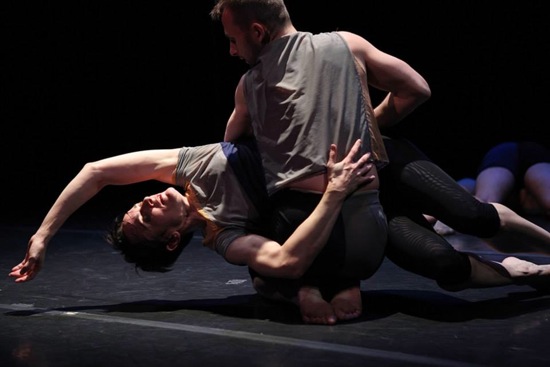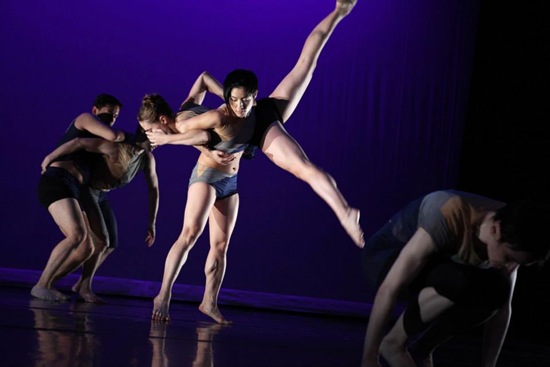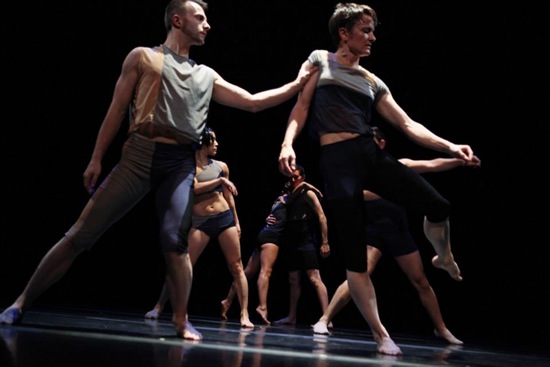Gina Gibney Dance premieres Dividing Line at Florence Gould Hall. November 14-16.
Gina Gibney is a force on the New York dance scene. The force behind Gibney Dance Community Action, a program that stages workshops (over 500 annually) for survivors of domestic violence . The force behind the Gibney Dance Center at 19th Street and Broadway, where Barbara Matera’s immense theatrical costume shop, one large studio, three (?) smaller ones, and Gibney’s office have been transformed into seven handsome rental studios of various dimensions, from soloist-size to Broadway-musical-size, plus amenities (a lunchroom for instance). As a choreographer, she knows what dance can achieve in the world and what creators need to be able to reach their goals.
How she finds time to make dances herself is a wonder. She’s not prolific—her newest work, Dividing Line, developed over the course of a year, in collaboration with its dancers. Still, she’s been choreographing for over two decades, using her humanistic vision and her interest in dancers as individuals to make thoughtful, powerfully physical works.
Dividing Line, which premiered in the French Alliance:Alliance Française’s Florence Gould Hall, is a handsome production, with lighting by Kathy Kaufmann, sleek costumes by David C. Woolard, and a tailor-made score by Son Lux (Ryan Lott). Lott’s excellent music is played on stage by members of the American Contemporary Music Ensemble (ACME): Clarice Jensen, cello; Ben Russell and Caroline Shaw, violins; and (at the performance I saw) Caleb Burns, viola.

Gina Gibney’s Dividing Line. (L to R, front to back): Zachary Leigh Denison, Amy Miller, Javier Baca, Natsuki Arai, Jennifer McQuiston Lott, Jake Bone. Photo: Julieta Cervantes
Gibney’s title spawns numerous possibilities: divisions in space; personal moral quandaries; and divisions that separate humans—whether by age, gender, or beliefs, or just by quarrels over dinner. Dividing Line’s initial expression of this theme is a spatial one. The six dancers are lined up across the front of the stage, their backs to us. (Oh, right, there’s that fence too: the one between spectators and performers.) Amy Miller takes the first adventurous steps out of the line, making us sense that the terrain between her and the black curtain at the back of the stage is a slightly dangerous one; Natsuki Arai starts after her. Before long, the others—Javier Baca, Jake Bone, Zachary Leigh Denison, and Jennifer McQuiston Lott—have broken ranks and are showing themselves as individuals, sharing the space in their own ways.
Before long, Gibney has shown us other imaginary lines. Partners lean together, braced shoulder to shoulder, in a line of couples that stretches from the front to the back of the stage. Then they break away from that stressful but tidy structure. Two people grab hands and pull against each other. If someone or something were to sever the point of contact, the formation would topple. Other lines are less obvious. How many things can separate people from other people? One duet ends in an embrace, another in separation, another in a questioning look.
In Dividing Line’s many short sections, Gibney shows a predilection for strong, expansive movement, plus what almost amounts to a love affair with the floor. The dancers seem to spend almost as much time anchored to it in various inventive ways as a hip-hop dancer might. Miller, lying down, rolls and twists her way around a perfect circle. (There was a point, maybe in an encounter between Baca and Denison, when I wished that they’d get to their feet, but perhaps Gibney was thinking of creatures—whether human or animal—slinking laboriously around as they size each other up.)
But not every move is a whole-bodied one. The choreography can make you focus on a raised foot that a dancer, prone on the floor, is slowly lowering. In one duet, Miller and Denison reach behind themselves and use one hand to prick the other palm, as if sending a covert message in Morse Code. Gibney is adept at breaking unison into counterpoint. She also stitches rhythmic, dynamic, and spatial variations into her phrases of movement, so there’s almost always something compelling— and sometimes surprising—to look at, such as some hunky, spraddle-legged walks amid the smoother dancing.
The dancers are very fine. Miller has the most to do, and she is a powerful performer—lean and strong, capable of giving expressive nuances to her dancing. Bone, who only came into the process a month ago, has the least time onstage. Arai, Baca, and Denison emerge as prominent, while Lott (whom I admired very much) is less so. This slight inequality among the five puzzles me slightly (I find myself thinking of Miller as a leader, a “heroine,” and then having to suppress that feeling because the choreography doesn’t pursue this as a possible thread).
I admire Baca’s ease onstage and the way he looks interested in whomever he’s dancing with. When he and Miller move to plucked strings and what sounds close to musical meows coming from the instruments, he brings out the playfulness in her (they exit on opposite sides of the stage, however).
Midway through the piece, the black curtains open, and Kaufmann’s lighting opens up the space—tinting the back wall lavender or giving it an orange glow. Midway, too, I ask myself what is everything leading to? Or, considering Dividing Line as variations on a theme, is it meant to lead to anything? The ending sends an unexpectedly strong, yet enigmatic message. After some lively dancing to very perky music, the dancers shed their onstage manners and walk toward the front of the stage—not in lockstep, but informally, as if the show were over. The lights turn them into silhouettes, as they reach their hands out to one another. But there’s enough illumination for us to see Miller turn and start toward the rear of the stage; suddenly she freezes and looks back over her shoulder at the others, who remain facing the audience. Has she changed her mind about leaving this warm and spirited little community? Blackout.



